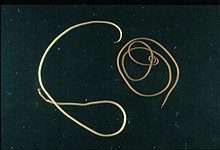Hairworm
| Nematomorpha | |
|---|---|
 |
|
| Paragordius tricuspidatus | |
| Scientific classification | |
| Kingdom: | Animalia |
| Clade: | Nematoida |
| Phylum: |
Nematomorpha Vejdovsky, 1886 |
| Subgroups | |
Nematomorpha (sometimes called Gordiacea, and commonly known as horsehair worms or Gordian worms) are a phylum of parasitoid animals superficially similar to nematode worms in morphology, hence the name. They range in size in most species from 50 to 100 millimetres (2.0 to 3.9 in) long and can reach in extreme cases up to 2 metres, and 1 to 3 millimetres (0.039 to 0.118 in) in diameter. Horsehair worms can be discovered in damp areas such as watering troughs, swimming pools, streams, puddles, and cisterns. The adult worms are free-living, but the larvae are parasitic on arthropods, such as beetles, cockroaches, mantids, orthopterans, and crustaceans. About 351 freshwater species are known and a conservative estimate suggests that there may be about 2000 freshwater species worldwide. The name "Gordian" stems from the legendary Gordian knot. This relates to the fact that nematomorpha often tie themselves in knots.
Nematomorphs possess an external cuticle without cilia. Internally, they have only longitudinal muscle and a non-functional gut, with no excretory, respiratory or circulatory systems. The nervous system consists of a nerve ring near the anterior end of the animal, and a ventral nerve cord running along the body.
Reproductively, they are dioecious, with the internal fertilization of eggs that are then laid in gelatinous strings. Adults have cylindrical gonads, opening into the cloaca. The larvae have rings of cuticular hooks and terminal stylets that are believed to be used to enter the hosts. Once inside the host, the larvae live inside the haemocoel and absorb nutrients directly through their skin. Development into the adult form takes weeks or months, and the larva moults several times as it grows in size.
...
Wikipedia
